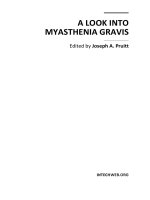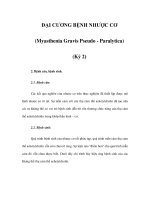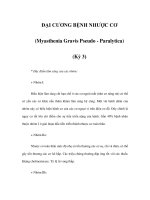AZATHIOPRINE IMMUNOSUPPRESSIVE DRUG FOR MYASTHENIA GRAVIS
Bạn đang xem bản rút gọn của tài liệu. Xem và tải ngay bản đầy đủ của tài liệu tại đây (1.14 MB, 21 trang )
AZATHIOPRINEIMMUNOSUPPRESSIVE DRUG
FOR MYASTHENIA GRAVIS
NEUROLOGY DEPARTMENT
CONTENT
• Generalle Information
• Treatment-Immunosuppressants:
– Azathioprine
• Conclusion
I. General Information
• Myasthenia gravis (MG)
is an autoimmune
disorder characterized
by fluctuating muscle
weakness and
fatigability on exertion,
in which autoantibodies
to proteins of the
neuromuscular junction
(NMJ) are
pathogenically relevant
Distribution of weakness
• Ocular 17%
• Ocular and bulbar 13%
– Mild 2%
– Moderate/severe 11%
• Ocular and limb 20%
• Generalised 50%
–
–
–
–
–
Mild 2%
Moderate 14%
Severe 15%
Assisted ventilation 11%
Died despite ventilation 8%
1 Start pyridostigmine following protocol.
2. ACh-R antibody seropositive and aged under 45 years: consider thymectomy.
3. If symptomatic despite pyridostigmine, start prednisolone (generally given on
alternate days.
4. If relapse occurs on prednisolone withdrawal at a dose of 7.5–10 mg/day (or
15–20 mg alternate days) or greater, introduce immunosuppression.
Immunosuppression may also be used for patients with corticosteroid-related
side effects on low-dose prednisolone.
II.AZATHIOPRINE
• Azathioprine, a
prodrug of 6mercaptopurine (6MP), interferes in
purine nucleotide
synthesis and
metabolism which
makes it an effective
inhibitor of
lymphocyte
proliferation
• Azathioprine is the first-line agent
• Azathioprine is slow to achieve maximum
effect
• The prednisolone dose and clinical outcome were compared in a
multicenter randomized double-blind study of 34 MG patients who
were followed up for mgkg); the other group received prednisolone
on alternate days plus placebo (PRED + PLAC).
• Initial high-dose prednisolone (1.5 mgkg on alternate days) was
tapered at remission to the minimal dose required to maintain
remission. 3 years.
• One group (PRED + AZA) received prednisolone (on alternate days)
plus azathioprine (2.5
• The prednisolone dose did not differ significantly between the two
groups at 1 year (median values: PRED + AZA, 37.5 mg on
alternate days; PRED + PLAC, 45 mg on alternate days) but was
reduced at 2 and 3 years in the PRED + MA group (median value at
3 years: PRED + AZA, 0 mg on alternate days; PRED + PLAC, 40
mg on alternate days; p = 0.02).
• Relapses and failures to remit over the 3 years were more frequent
in the PRED + PLAC group. There was a sharp rise in the antiacetylcholine receptor (AChR) titers in the PRED + PLAC group at 2
years. Incidence of side effects was slightly less in the PRED + MA
group.
• Azathioprine as an adjunct to alternate day prednisolone in
the treatment of antibody-positive generalized MG
reduces the maintenance dose of prednisolone and is
associated with fewer treatment failures, longer
remissions, and fewer side effects.
Azathioprine (Aza) has been used alone or in combination with
steroids for two groups of myasthenic patients. Positive
responses were noted in 75% of patients on Aza alone and in
70% receiving the combined regimen. The clinical course of the
two groups differed in terms of respiratory crisis and need for
plasma exchange. With an appropriate Aza administration
schedule side-effects were not a limiting factor to its use. Aza
treatment induced a reduction in anti-AchR-antibody level
that was correlated with clinical improvement and greatly
decreased the need for steroids.
Toxicities of Immunosuppressive
Medications-Azathioprine
• Nausea and vomiting in about 22% of patients
• Pancreatitis and hepatotoxicity have also been
reported and these symptoms occur within the first
3-6 months
• Leucopenia and thrombocytopenia
• Malignancies are known to occur in azathioprine
treated patients but the exact incidence is
unknown: lymphoma, squamous cell carcinomas
of the skin, Kaposi's sarcoma, in situ carcinomas
of the cervix, carcinomas of the vulva and
perineum, hepatobiliary carcinoma, and
mesenchymal tumors
Conclusion
• Azathioprine still remains the first choice for
longterm immunosuppressive therapy.
However, it is important to point out that there
are only very limited data from controlled
studies on the efficacy of azathioprine.
• A significant disadvantage of azathioprine is
the delayed onset of action. Commonly,
azathioprine is therefore started combined
with prednisolone to achieve a rapid
therapeutic effect.
REFERENCE
• Myasthenia gravis: Association of British Neurologists’
management Guidelines-Jon Sussman, Maria E Farrugia,
Paul Maddison, Marguerite Hill, M Isabel Leite, David HiltonJones
• Autoimmune myasthenia gravis: emerging clinical and
biological Heterogeneity-Matthew N Meriggioli, MD 1 and
Donald B Sanders, MD
• Diagnosis and management of myasthenia gravis-Sivakumar
Sathasivam MRCP (UK), LLM, PhD- Progress in Neurology
and Psychiatry January/February 2014
• Toxicities of Immunosuppressive Treatment of Autoimmune
Neurologic Diseases- Enrico C. Lallana and Camilo E. Fadul *









